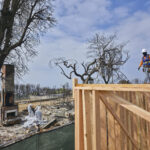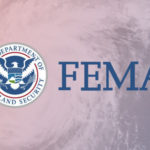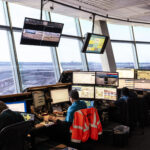Rapid population growth and the desire to live near forests means new housing in western Montana is being built in wildfire-prone areas, increasing taxpayer-funded fire suppression liabilities and putting lives and property in danger, according to a new study.
Half of all new homes built in Missoula County between 1990 and 2016 were in areas at high or moderate risk from wildfires. In Ravalli County, more than 90 percent of homes built in the same period were at “high wildfire hazard,” says a report from Headwaters Economics in Bozeman.
Ravalli County’s 6,987 houses built in high hazard areas in that 26-year period is more than in all other western Montana counties combined.
In Missoula County, 2,234 houses were built in the most fire-prone areas and another 2,153 were built in moderately dangerous areas.
Chris Mehl, the deputy mayor of Bozeman and the policy director at Headwaters Economics, said Missoula and Ravalli counties have topography that causes development in the wildland-urban interface.
“It’s not surprising that Missoula and Ravalli are way ahead of everyone else,” he told the Missoulian. “Gallatin County is growing faster but we’re not building them in the woods as much.”
Missoula County Commissioner Dave Strohmaier said he doesn’t think the county has weighed wildfire risk heavily enough in land-use decisions in the past, but he believes that is changing.
The county has a Community Wildfire Protection Plan and subdivision regulations that are intended to mitigate the risks of development. Also, a Community Mitigation Assistance Team was coming to Missoula to talk about a cohesive, community-wide wildfire response strategy.
“The challenge in how our community and how our county grows is that you have various competing interests,” he explained. “There are concerns that we not build in prime agricultural soils. And that you don’t want to be building in wildlife habitat or corridors or riparian areas or other areas of cultural significance. So you start narrowing down areas of truly developable land.”
As a result, he said, people start “eyeing” upland areas with forests or grasslands and saying “why don’t we build there?”
“Couple that with the fact that, traditionally, folks in Montana and throughout the West, for that matter, like to live where they want to live without being overly regulated,” he said. “You have people building in highly flammable landscapes that have traditionally burned and are adapted to fire and need to burn and will burn.”
What happens, he said, is that people living in the fire prone areas individually benefit from a nice place to live while not taking on the full cost of the wildfire risk. “You’ve privatized the benefits and socialized the costs.
“When wildfire occurs, we all pick up the tab,” he added. “We’re kind of disproportionately deploying resources to where arguably people shouldn’t be living in the first place.”
Headwaters, an independent research firm, used data from the Montana Department of Revenue and Missoula-based wildfire threat assessment research firm Pyrologix.
Pyrologix was hired by the U.S. Forest Service Northern Region to compile the data. To determine which areas are high wildfire hazard areas, the company used wildfire simulation modeling that incorporates the likelihood of a wildfire burning, the intensity of a fire if it were to occur and the “generic susceptibility” of a structure to those intensities. The 25 counties in western Montana studied were categorized by the Forest Service into three classes based on relative hazard: High, moderate and low.
Headwaters found that if development near fire-prone forests continues and global temperatures continue to rise, fire suppression costs in Montana will increase by at least $4 million every year. The report said that is a conservative estimate, because recent studies in Oregon and Northern California show that there are higher firefighting costs associated with low-density development of new homes and much of firefighting costs are estimated to be attributable to the defense of private property.
Ravalli County Commissioner Jeff Burrows said the Bitterroot Valley’s geography has meant lots of development in the wildland-urban interface, a term for where human development meets fire prone areas.
“In Ravalli County, we’re 73 percent national forest and public land,” he said. “Basically anywhere you build is in the wildland-urban interface. There’s not a lot of area to build. And a lot of the lower areas of the valley, by the time you take out private property and floodplain areas . between the bottom and where you get to the National Forest boundary there’s not a lot of property left in between there.
“Just the way we’re set up, a long skinny valley, there’s inherent conflicts.”
In 2008, Ravalli County voters repealed the county’s growth policy by a vote of 9,674 to 8,367. State law requires counties to have a growth policy before they can adopt zoning rules to dictate residential and commercial construction areas, stream-side setbacks and other land-use regulations.
The county does have several dozen citizen-initiated zoning districts that give local landowners a say in guiding future development. The county also has subdivision regulations that give the Planning Department staff the authority to determine whether to apply certain design standards to subdivisions in high fire hazard areas. Applicants for subdivisions in these areas also must provide a high fire hazard area management plan completed by a professional forester or someone with accredited knowledge in fire suppression for all lots and roadways within the subdivision, including any open space or fuel breaks.
Burrows noted the county encourages citizens to take advantage of the Montana Department of Natural Resources and Conservation’s fuels mitigation program, which provides a 50/50 cost-sharing split for landowners to reduce hazardous fuels on their property.
“We do have a community wildfire protection plan,”’ he said. “Yeah, we’ve got houses that have been built that don’t have the best access (for fire responders) but there is grant money available. The Forest Service is working hard on fuels reduction on their side of the boundary.”
Wildfire suppression costs are handled mainly by the state and federal governments, but having lots of residential development in high wildfire hazard areas indirectly affects local budgets, Burrows said.
“There’s an impact of fire traffic on roads,” he said. “Wildfires affect the public safety budget through dispatch, the Sheriff’s Office and the Office of Emergency Management.”
In Ravalli County in the summer of 2017, more than 200 homes built near forested areas had to be evacuated due to the Lolo Peak fire. In the summer of 2016, the Roaring Lion fire near Hamilton burned 16 homes and claimed one life, eventually costing $11 million to fight.
Jim Knapp, the chief of the Corvallis Rural Fire District, said the summers of 2016 and 2017 were stressful and expensive for fire personnel in the valley, who all help each other out in times of need.
“Since 2000, it seems like every year all the valley fire departments just wonder where the fire’s gonna hit this year,” he said. “I think it’s inevitable that growth will occur in the wildland-urban interface, but I also feel that counties around the state are starting to address some of the concerns.
“Everybody’s kind of waking up to that, realizing that if we build in those kinds of areas we have some kind of responsibility to use the right types of building materials and have access roads with ingress and egress in case of an emergency.”
Knapp believes all the fires in the last two decades have taught governments and fire personnel a lot about residential development’s risks.
“I think we’re going to continue to see a little bit more responsible growth in the wildland-urban interface,” he said.
Montana’s 2017 wildfire season was the state’s worst on record, with more than a million acres going up in smoke. Places like Missoula and Seeley Lake saw long periods of unhealthy air and a drop in tourism revenue. That summer’s firefighting came at a total cost of $400 million, with a record $74 million of that falling on state taxpayers.
From 1990 to 2016, Missoula County’s population grew 47 percent while Montana’s overall population grew by 30 percent. The county accounted for 10 percent of all homes built in Montana in that time period, 11,678.
Strohmaier remembers two subdivisions that were recently approved in the county, one in a thick pine forest and one on an irrigated pasture, that were both rated as having a moderate fire risk by the county’s metrics.
“Something is not quite right there,” he said. “The time is right. We need to take a hard look at land use planning. If there’s any place in the country that ought to be at the tip of the spear when it comes to thinking about fire and how to be adaptable and resilient, it ought to be here in Missoula with the Fire Sciences Laboratory right here.”
He also said that a proposed open space bond on the November ballot could help, if passed, to mitigate wildfire risks. Money from the bond could be used “to limit development in the higher risk areas in the wildland-urban interface to make us more resilient to fire.”
Paul Finlay, the assistant fire chief at the Missoula Rural Fire District, said he and his staff know there’s a lot of development in the forested areas around Missoula.
“We continue to try to deal with that as best we can through some efforts we have going on all the time,” he said. “We have classes and we have a fuel mitigation program we sponsor, as well, to help homeowners in the wildland-urban interface better protect their home.”
Finlay said the drainages in the valley, such as Rattlesnake Creek, Grant Creek and O’Brien Creek, have seen lots of development pressure in forested hillsides.
“Our biggest concerns are areas with the most growth, and that includes the Highway 12 corridor, which has been impacted a number of times in the past few years by wildland fire,” he said. “The Highway 200 corridor (east of Missoula) is a part of that.”
Finlay said his department responds to fire calls year-round.
“The houses are less frequent, I would say, but nonetheless the challenges are dramatically more with access and the ability to work around them,” he said of the wildland-urban interface. “There’s tight spots among the trees.”
Finlay said he wouldn’t call development in the interface a burden, but acknowledged that houses in these areas present a special challenge.
“It certainly impacts our response times,” he said. “A fire department is challenged in a number of ways, and that happens to be one of the challenges we face every day in homes in the outer reaches.”
Was this article valuable?
Here are more articles you may enjoy.

 In The Wake of Devastating LA Fires, Residents Begin to Rebuild
In The Wake of Devastating LA Fires, Residents Begin to Rebuild  Instagram Suggested ‘Groomers’ Connect With Minors, FTC Says
Instagram Suggested ‘Groomers’ Connect With Minors, FTC Says  Acting FEMA Chief Is Ousted After Less Than 4 Months
Acting FEMA Chief Is Ousted After Less Than 4 Months  Flyers Avoiding Newark Airport Over Safety Fears
Flyers Avoiding Newark Airport Over Safety Fears 